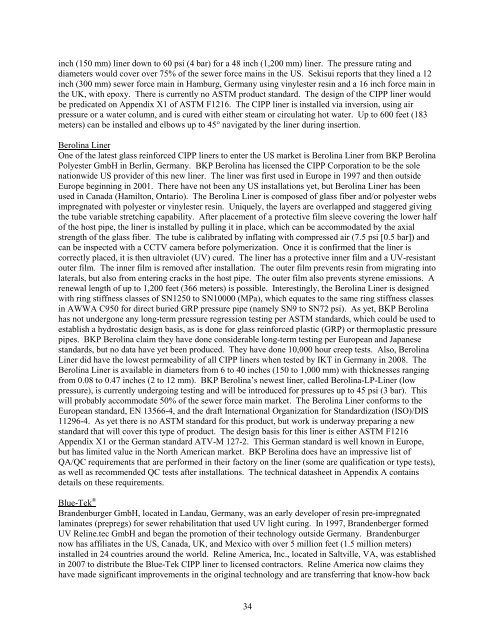State of Technology Report for Force Main Rehabilitation, Final ...
State of Technology Report for Force Main Rehabilitation, Final ...
State of Technology Report for Force Main Rehabilitation, Final ...
You also want an ePaper? Increase the reach of your titles
YUMPU automatically turns print PDFs into web optimized ePapers that Google loves.
inch (150 mm) liner down to 60 psi (4 bar) <strong>for</strong> a 48 inch (1,200 mm) liner. The pressure rating and<br />
diameters would cover over 75% <strong>of</strong> the sewer <strong>for</strong>ce mains in the US. Sekisui reports that they lined a 12<br />
inch (300 mm) sewer <strong>for</strong>ce main in Hamburg, Germany using vinylester resin and a 16 inch <strong>for</strong>ce main in<br />
the UK, with epoxy. There is currently no ASTM product standard. The design <strong>of</strong> the CIPP liner would<br />
be predicated on Appendix X1 <strong>of</strong> ASTM F1216. The CIPP liner is installed via inversion, using air<br />
pressure or a water column, and is cured with either steam or circulating hot water. Up to 600 feet (183<br />
meters) can be installed and elbows up to 45° navigated by the liner during insertion.<br />
Berolina Liner<br />
One <strong>of</strong> the latest glass rein<strong>for</strong>ced CIPP liners to enter the US market is Berolina Liner from BKP Berolina<br />
Polyester GmbH in Berlin, Germany. BKP Berolina has licensed the CIPP Corporation to be the sole<br />
nationwide US provider <strong>of</strong> this new liner. The liner was first used in Europe in 1997 and then outside<br />
Europe beginning in 2001. There have not been any US installations yet, but Berolina Liner has been<br />
used in Canada (Hamilton, Ontario). The Berolina Liner is composed <strong>of</strong> glass fiber and/or polyester webs<br />
impregnated with polyester or vinylester resin. Uniquely, the layers are overlapped and staggered giving<br />
the tube variable stretching capability. After placement <strong>of</strong> a protective film sleeve covering the lower half<br />
<strong>of</strong> the host pipe, the liner is installed by pulling it in place, which can be accommodated by the axial<br />
strength <strong>of</strong> the glass fiber. The tube is calibrated by inflating with compressed air (7.5 psi [0.5 bar]) and<br />
can be inspected with a CCTV camera be<strong>for</strong>e polymerization. Once it is confirmed that the liner is<br />
correctly placed, it is then ultraviolet (UV) cured. The liner has a protective inner film and a UV-resistant<br />
outer film. The inner film is removed after installation. The outer film prevents resin from migrating into<br />
laterals, but also from entering cracks in the host pipe. The outer film also prevents styrene emissions. A<br />
renewal length <strong>of</strong> up to 1,200 feet (366 meters) is possible. Interestingly, the Berolina Liner is designed<br />
with ring stiffness classes <strong>of</strong> SN1250 to SN10000 (MPa), which equates to the same ring stiffness classes<br />
in AWWA C950 <strong>for</strong> direct buried GRP pressure pipe (namely SN9 to SN72 psi). As yet, BKP Berolina<br />
has not undergone any long-term pressure regression testing per ASTM standards, which could be used to<br />
establish a hydrostatic design basis, as is done <strong>for</strong> glass rein<strong>for</strong>ced plastic (GRP) or thermoplastic pressure<br />
pipes. BKP Berolina claim they have done considerable long-term testing per European and Japanese<br />
standards, but no data have yet been produced. They have done 10,000 hour creep tests. Also, Berolina<br />
Liner did have the lowest permeability <strong>of</strong> all CIPP liners when tested by IKT in Germany in 2008. The<br />
Berolina Liner is available in diameters from 6 to 40 inches (150 to 1,000 mm) with thicknesses ranging<br />
from 0.08 to 0.47 inches (2 to 12 mm). BKP Berolina’s newest liner, called Berolina-LP-Liner (low<br />
pressure), is currently undergoing testing and will be introduced <strong>for</strong> pressures up to 45 psi (3 bar). This<br />
will probably accommodate 50% <strong>of</strong> the sewer <strong>for</strong>ce main market. The Berolina Liner con<strong>for</strong>ms to the<br />
European standard, EN 13566-4, and the draft International Organization <strong>for</strong> Standardization (ISO)/DIS<br />
11296-4. As yet there is no ASTM standard <strong>for</strong> this product, but work is underway preparing a new<br />
standard that will cover this type <strong>of</strong> product. The design basis <strong>for</strong> this liner is either ASTM F1216<br />
Appendix X1 or the German standard ATV-M 127-2. This German standard is well known in Europe,<br />
but has limited value in the North American market. BKP Berolina does have an impressive list <strong>of</strong><br />
QA/QC requirements that are per<strong>for</strong>med in their factory on the liner (some are qualification or type tests),<br />
as well as recommended QC tests after installations. The technical datasheet in Appendix A contains<br />
details on these requirements.<br />
Blue-Tek ®<br />
Brandenburger GmbH, located in Landau, Germany, was an early developer <strong>of</strong> resin pre-impregnated<br />
laminates (prepregs) <strong>for</strong> sewer rehabilitation that used UV light curing. In 1997, Brandenberger <strong>for</strong>med<br />
UV Reline.tec GmbH and began the promotion <strong>of</strong> their technology outside Germany. Brandenburger<br />
now has affiliates in the US, Canada, UK, and Mexico with over 5 million feet (1.5 million meters)<br />
installed in 24 countries around the world. Reline America, Inc., located in Saltville, VA, was established<br />
in 2007 to distribute the Blue-Tek CIPP liner to licensed contractors. Reline America now claims they<br />
have made significant improvements in the original technology and are transferring that know-how back<br />
34















